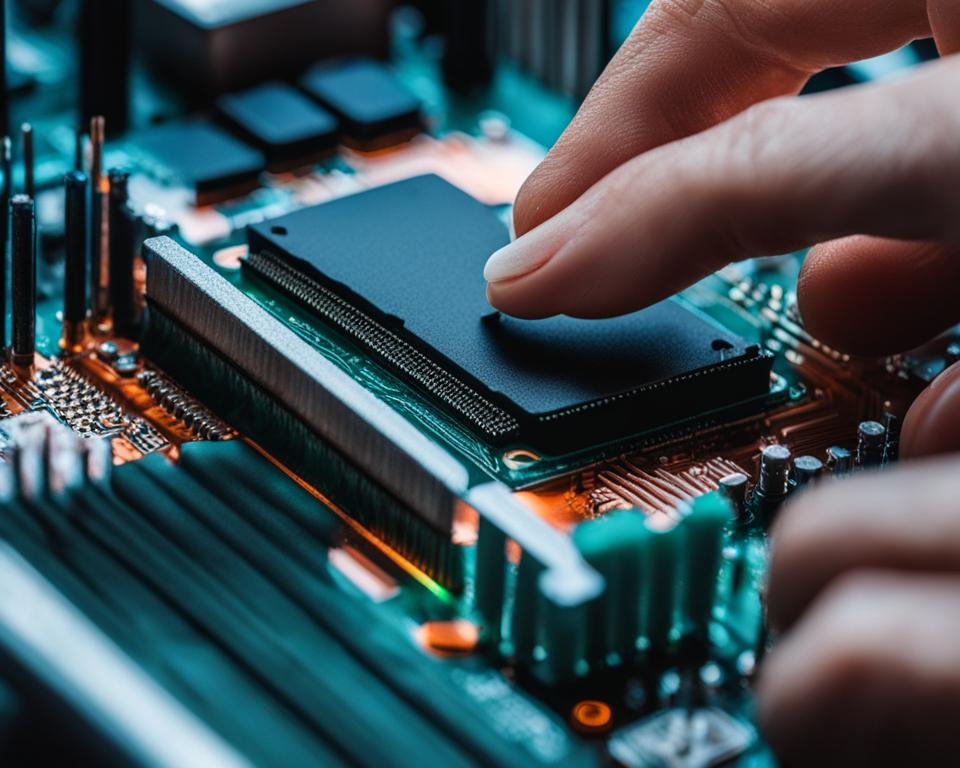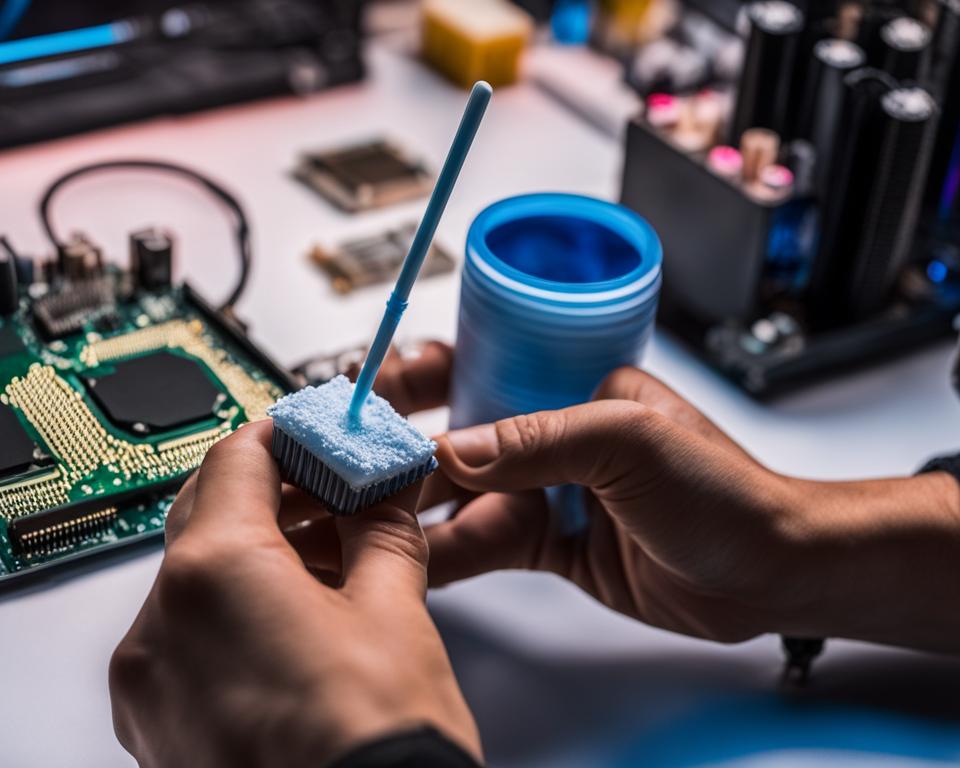Imagine you’re a passionate gamer, eagerly awaiting the release of a highly anticipated game. You’ve spent weeks researching the best components for your gaming rig, carefully selecting the perfect CPU and cooler for maximum performance. Finally, the day arrives, and you excitedly start assembling your new system.
As you carefully mount the CPU onto the motherboard, you can’t help but notice the remnants of the old thermal paste clinging stubbornly to its surface. Knowing that thermal paste plays a crucial role in heat transfer and cooling, you realize that removing the old paste is essential for optimal performance.
But how do you go about removing thermal paste safely? How do you ensure that your newly assembled gaming beast operates at its full potential?
In this article, we will guide you step by step through safe and effective methods for removing thermal paste from your CPU. Whether you’re a gaming enthusiast, a PC builder, or simply someone looking to optimize their computer’s performance, this guide will equip you with the knowledge and techniques to clean off the old thermal paste and pave the way for a fresh application.
Key Takeaways:
- Removing old thermal paste is crucial for optimal heat transfer and cooling efficiency.
- Proper cleaning and removal of thermal paste ensure a clean surface for reapplication.
- Regular maintenance of thermal paste helps extend the lifespan of your components.
- Video tutorials can provide visual guidance for removing and applying thermal paste.
- Consider using thermal pads as an alternative to thermal paste for convenient and long-lasting performance.
Why Remove Thermal Paste?

Removing thermal paste is a necessary step in various scenarios to ensure optimal performance and temperature management in your computer. If you notice that your PC is running hot or the fans are constantly loud, it may indicate that the thermal paste needs to be replaced. Thermal paste acts as a conductive medium between the CPU and the heat sink, allowing for efficient heat transfer.
When upgrading the CPU cooler or reusing an old CPU on a new motherboard, it is essential to remove the existing thermal paste. This ensures a clean surface for reapplication and helps maintain proper heat dissipation.
By removing old thermal paste, you can eliminate any residue or buildup that may impede heat transfer, causing thermal throttling or overheating issues. This process also allows for a fresh application of new thermal paste, which can improve cooling efficiency and extend the lifespan of your components.
“Removing thermal paste is an essential maintenance task to ensure optimal cooling and performance in your computer.”
To better understand the importance of removing thermal paste, consider the following analogy: just as you clean and prepare a surface before applying a new coat of paint, removing old thermal paste allows for a clean and smooth surface for reapplication. This helps establish a proper thermal interface between the CPU and the cooler, maximizing heat dissipation.
Without removing old thermal paste, the accumulated residue may act as a thermal insulator, hindering proper heat transfer. As a result, your CPU may experience higher temperatures, reduced performance, and potentially even thermal shutdowns.
To illustrate the significance of removing thermal paste, let’s take a closer look at a real-world example:
| Scenario | Effect on CPU Temperature |
|---|---|
| System A: No thermal paste removal | Elevated temperatures due to inadequate heat dissipation |
| System B: Proper thermal paste removal | Improved cooling efficiency and optimal performance |
As the table demonstrates, removing old thermal paste significantly impacts CPU temperature and overall system performance. By following proper thermal paste removal techniques, you can effectively maintain your computer’s temperature management and safeguard your components from potential harm.
Now that we understand the importance of removing thermal paste, let’s move on to the step-by-step guide for proper removal and cleaning in Section 3.
Steps to Remove Thermal Paste

When it comes to removing thermal paste from your CPU, it’s essential to follow the right steps to ensure a clean and safe process. Here’s the best way to remove thermal paste:
- Gather the Required Materials: Before starting, make sure you have the following materials on hand:
- Isopropyl alcohol (preferably 90% or higher concentration)
- Cotton swabs or lint-free cloth
- Non-abrasive cleaning wipes
- Disposable gloves (optional)
Following these steps will ensure that you remove the thermal paste from your CPU effectively, leaving behind a clean surface for applying new thermal paste. Remember to handle your components with care and work in a well-ventilated area to avoid any mishaps.
| Step | Description |
|---|---|
| 1 | Gather the Required Materials |
| 2 | Prepare the Workstation |
| 3 | Dismantle the CPU Cooler |
| 4 | Clean the CPU Cooler |
| 5 | Apply Isopropyl Alcohol to the CPU Surface |
| 6 | Repeat the Cleaning Process |
| 7 | Inspect for any residual thermal paste |
Applying New Thermal Paste

Once the old thermal paste is removed, it’s crucial to apply new thermal paste correctly to ensure optimal heat transfer. Follow these steps:
- Start by preparing the necessary materials. You will need:
- A high-quality thermal paste (such as Arctic Silver 5 or Noctua NT-H1)
- A clean microfiber cloth or lint-free cloth
- A plastic card or spatula for spreading the paste
Remember, using the right amount of thermal paste is crucial – too much or too little can affect heat transfer and cooling efficiency. Refer to the manufacturer’s guidelines for the recommended amount of paste to use.
Now that you’ve applied the thermal paste, you’re one step closer to optimal cooling performance for your CPU.
Cleaning the CPU Cooler

When removing thermal paste, it’s crucial to also clean the CPU cooler to ensure optimal performance. Residue or old thermal paste left on the cooler can impede proper heat transfer and compromise cooling efficiency. To clean the CPU cooler, follow these steps:
- Gather your materials: Prepare isopropyl alcohol (at least 90% concentration) and a cloth or cotton swab.
- Disconnect and remove the cooler: Carefully detach the CPU cooler from the motherboard, following the manufacturer’s instructions or your PC’s manual.
- Dampen the cloth or cotton swab: Apply a small amount of isopropyl alcohol to the cloth or cotton swab to make it slightly damp.
- Clean the cooler: Gently scrub the surface of the cooler, targeting any visible residue or remaining thermal paste. Be thorough but avoid applying excessive pressure to prevent damage.
- Remove stubborn residue: If stubborn residue persists, you can use a plastic or non-abrasive brush to carefully dislodge it.
- Dry the cooler: Allow the CPU cooler to air dry completely or use a lint-free cloth to gently pat it dry.
Once both the CPU and CPU cooler surfaces are completely clean, you can proceed with the reinstallation process.
Precautions:
Be cautious when handling the CPU cooler to avoid accidental damage. Gentle and deliberate movements are key.
Ensure that the CPU cooler is completely dry before reattaching it to the motherboard to prevent any moisture from interfering with the thermal paste application.
| What to Use | What to Avoid |
|---|---|
|
|
How Often Should You Replace Thermal Paste?
Regularly replacing thermal paste is crucial for maintaining optimal performance and temperature management in your computer. Over time, thermal paste may degrade, dry out, or lose its effectiveness, which can lead to higher temperatures and reduced performance. It is recommended to replace the thermal paste every few years or whenever you remove the CPU cooler. By doing so, you ensure proper heat transfer and cooling efficiency.
| Signs that indicate the need for thermal paste replacement: |
|---|
| 1. Elevated CPU temperatures |
| 2. Excessive fan noise |
| 3. CPU overheating and system crashes |
| 4. Upgrading the CPU cooler or reusing an old CPU on a new motherboard |
By replacing the thermal paste regularly, you maintain optimal cooling performance, prolong the lifespan of your components, and prevent potential hardware failures.
“Thermal paste degradation can significantly impact heat dissipation and overall system performance. Regular replacement is the key to maintaining a cool and efficient computer.”
Frequency of Thermal Paste Replacement
The exact frequency of thermal paste replacement depends on several factors, including:
- The type and quality of the thermal paste used
- The operating conditions of your computer
- The intensity of CPU usage
- The ambient temperature
However, as a general guideline, replacing the thermal paste every 2-3 years is recommended for most users. If you are an avid gamer, overclock your CPU, or use resource-intensive applications, more frequent replacements may be necessary to maintain optimal thermal performance.
Remember, proper and timely replacement of the thermal paste is essential for preventing heat-related issues and ensuring your computer operates at its best.
Do You Have to Use Thermal Paste?
While thermal paste is widely considered the most common and effective solution for heat transfer in computers, there are alternative options available, such as thermal pads. These pads offer a similar function to thermal paste but provide the added convenience of being easier to apply and offering a longer-lasting solution.
Thermal pads:
- Convenient and easy to use
- Long-lasting performance
- Provide good heat conductivity
- Avoid the messiness of thermal paste application
However, when using thermal pads, it’s important to ensure that you use a thermal interface material to fill the gap between the CPU and cooler. This material helps optimize heat dissipation and maintain efficient cooling performance.
Note: While thermal pads can be a viable alternative to thermal paste, it’s essential to follow manufacturer recommendations and consider specific requirements for your system to ensure optimal cooling and performance.
Video Tutorial for Thermal Paste Removal
For a visual guide on how to remove thermal paste, instructional videos available online provide step-by-step demonstrations on properly cleaning and applying thermal paste. These videos make it easier to follow the process and ensure that you remove the thermal paste effectively.
Watching a video tutorial can be especially helpful for visual learners who prefer to see the process in action. By observing the techniques used and following along, you can gain a better understanding of the best practices for removing thermal paste from your CPU.
When searching for video tutorials, look for ones that specifically focus on removing CPU thermal paste. These videos typically provide detailed instructions, tips, and tricks to ensure a safe and thorough cleaning process.
Remember that while instructional videos can be a valuable resource, it’s essential to cross-reference the information with other reliable sources to ensure accuracy and consistency.
Take a look at the following video tutorial to get started:
| Video Tutorial | Duration |
|---|---|
| How to Remove Thermal Paste from CPU | 10 minutes |
In this video tutorial, you’ll find comprehensive instructions on removing thermal paste from your CPU. From the tools you’ll need to the step-by-step process, this video will guide you through each stage of the cleaning process. Make sure to follow along carefully and take note of any additional tips provided by the tutorial.
Additional Tips for Thermal Paste Removal
While removing thermal paste from your CPU, here are some additional tips to ensure a thorough and effective cleaning process:
- Use isopropyl alcohol: Isopropyl alcohol is the best cleaning agent for removing thermal paste. It effectively dissolves the paste without leaving any residue behind. Ensure you use a high concentration of isopropyl alcohol (at least 70%) for optimal results.
- Apply gentle pressure: When cleaning the CPU and CPU cooler surfaces, use a soft cloth or cotton swab soaked in isopropyl alcohol. Apply gentle pressure to remove the thermal paste, being careful not to scratch or damage the surfaces.
- Be thorough: Take your time to clean all areas where thermal paste is present, including the edges and corners. Leftover residue can impede the efficiency of the new thermal paste, so ensure a complete and thorough cleaning.
- Dispose of used materials: After cleaning, discard the cloth or cotton swab used for removing the thermal paste. Avoid reusing them to prevent any contamination or debris from affecting the new application of thermal paste.
- Let it dry: After cleaning the surfaces, allow them to dry completely before applying new thermal paste. This ensures that there is no moisture that could interfere with the adhesion and performance of the new paste.
Remember, thorough cleaning of the CPU and CPU cooler surfaces is essential for optimal thermal paste application. Following these additional tips will help you achieve the best results and ensure efficient heat transfer in your computer system.
Isopropyl Alcohol Concentration Levels
| Concentration | Description |
|---|---|
| 70% | Commonly found in most pharmacies and is effective for cleaning purposes. |
| 90% | Has a higher concentration and is more efficient at removing tough stains and residues. |
| 99% | The purest form of isopropyl alcohol, ideal for sensitive electronic components and thorough cleaning. |
Conclusion
Properly maintaining thermal paste on your CPU is crucial for ensuring optimal cooling efficiency and performance. By carefully following the correct steps and using the appropriate materials, you can safely clean off and replace thermal paste, resulting in improved temperature management for your computer.
Regular maintenance of thermal paste helps to keep your system running smoothly and can significantly extend the lifespan of your components. By periodically inspecting and cleaning the thermal paste, you can prevent overheating, which can lead to system instability, decreased performance, and potential damage to your CPU.
Remember to use isopropyl alcohol and a cloth or cotton swab to clean off any old thermal paste residue before applying a fresh layer. Additionally, make sure to clean the CPU cooler to remove any buildup that could impede heat dissipation.
By prioritizing the removal and replacement of thermal paste in your computer maintenance routine, you are investing in the longevity and reliability of your system, ensuring that it performs at its best when you need it most.



